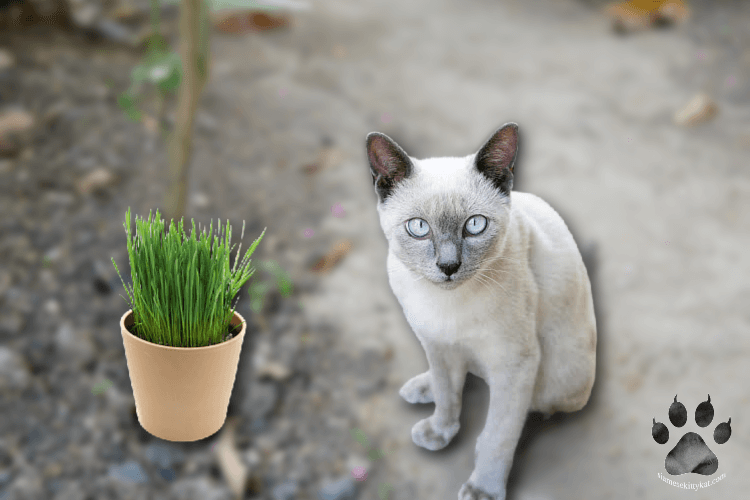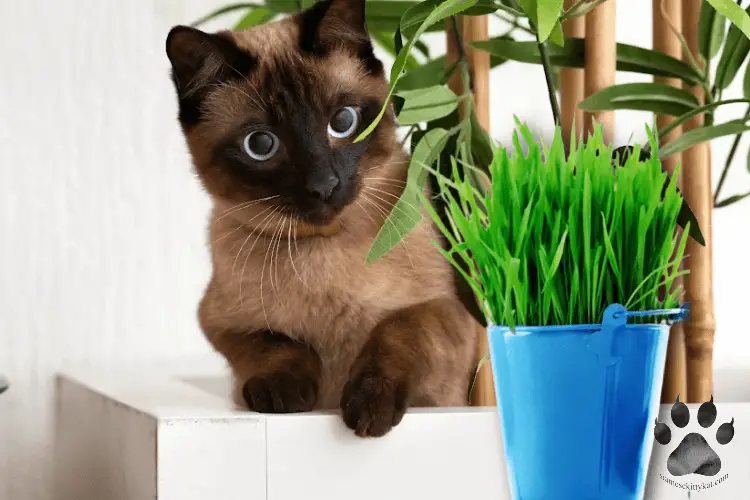Growing cat grass has been one of the best decisions I have ever made for my Siamese cats. I love to pamper my fur babies, and I always ensure I’m providing them with the best care and nutrition possible.
I have become quite an expert at growing cat grass over the years. It is pretty simple once you know the proper steps to take. This article will provide a step-by-step guide to help you get started!
What is Cat Grass?
Cat grass is a variety of cereal grasses considered safe and healthy for cats to consume. This may include wheatgrass, oat grass, rye grass, and barley grass. You can plant them indoors or outdoors for easy access.
These grasses are safe for your cat, but you must avoid giving them alfalfa or other sprouts.
There are many benefits associated with cat grass.
What are the Differences Between Catnip and Cat Grass?
Cat grass and catnip might appear the same at a glance. After all, both are small plants that seem to attract cats and make them happy. But in reality, these two are entirely different from one another.
Catnip
Catnip is also known as nepeta cataria. It is a mint family member containing the chemical nepetalactone. This chemical affects cats in the same way as marijuana does in humans – it triggers an emotional response in their brains and gets them “high” on its effects.
Many people often describe this feeling as a drug for cats. However, the effects of nepetalactone do not last long and do not cause any harm to your pet if they consume too much at once.
Cat grass
Cat grass does not affect a cat’s brain, but many cats are still drawn to it for some reason. This could be because it helps them to vomit up hairballs if they are having trouble doing so naturally. It could also be because it provides nutrients that support their digestive system.
Whether you choose to give your cat catnip or cat grass will depend on what benefits you want for your pet. Both have unique properties that can support your feline’s health and well-being. However, only you can decide which option is best for them!
Should I Grow Cat Grass?

There are many reasons why you might consider growing cat grass for your Siamese cat.
- This type of grass provides a safe and fibrous snack for your pet, which aids in their digestive health.
- Cat grass can help to induce vomiting. This makes it easier for Siamese cats to expel unwanted materials from their bodies.
- Cat grass serves as an effective deterrent against other animals who are attracted to your garden or houseplants, such as rabbits or rodents. Providing an alternative food source can reduce unwanted visitors munching on your plants.
- Growing cat grass is simple and inexpensive, only requiring a small space in your home or garden area.
Should I Use Cat Grass Kits or Grow My Own?
There are several factors to consider when deciding whether to use a cat grass kit or grow your own.
- Cost. Prepacked cat grass kits can often be quite expensive. This is especially true if you need to buy new seeds or other materials regularly. In contrast, growing your own cat grass allows you to save money. You can buy your seeds in bulk and reuse the same soil and containers.
- Convenience. A cat grass kit may be a better fit if you’re short in time or have limited space. It’s quick and easy to set up and requires minimal effort on your part once it’s started.
The kit comes with everything you need to get started. These include seeds, soil, containers, and instructions for growing the grass. This can be an excellent option for those who don’t have much experience with plants in general.
However, growing your own cat grass may be preferable if you have more time and space available. It gives you more control over the type of seeds used and the growing conditions.
How to Grow Cat Grass for Your Siamese Cat
Planting cat grass is a simple process that you can do indoors or outdoors, depending on your preferences and growing conditions.
- Start by preparing your growing area. Choose a spot that receives plenty of sunlight if you are planting cat grass outdoors. Ensure the area is well-drained. Clear any existing vegetation from the soil before planting.
Use a seed starting tray if you are planting indoors, or use a pot filled with potting soil. Make sure that you place your pot near a sunny windowsill.
Make sure to choose a spot where your cat will not have easy access and be able to disturb or destroy the plants.
- Once you have prepared your growing area, sow the seeds into the soil at a depth of about ¼ inch. Space the seeds 1 inch apart to allow for ample room for growth as the plants mature.
- Once you have planted your cat grass seeds, water them thoroughly to ensure good soil moisture. Keep the soil moist at all times during the germination period.
Be careful not to overwater, as this can damage the roots and cause your plants to die. You can use a spray bottle to water your cat grass regularly.
Cat grass may take several days to several weeks to germinate, depending on your growing conditions.
You may also need to thin out any seedlings that begin to crowd each other once they start growing.
- Once your cat grass reaches about 3 inches tall, you can begin to harvest small portions to use as a healthy and tasty treat for your feline. Sniff off thin portions around the base of each plant stem using scissors or garden shears.
Be sure not to harvest more than one-third of the plant’s total height, so it has enough resources left to continue growing and thriving.
You can easily plant and care for cat grass at home with these simple steps. This makes it easy to provide your furry friend with a healthy source of nutrition any time of year.
Growing cat grass at home has been one of the most rewarding experiences I’ve ever had as a pet owner. I started growing cat grass when my Siamese cat, Batman, began to have digestive issues.
The first time I set up my little indoor garden, Batman became obsessed
with the sprouts starting to pop up in the potting soil. He would eagerly check on his plants, gently sniffing and licking them.
The tiny sprouts grow after a few weeks, and Batman was happily munching away on his fresh greens.
Watching Batman enjoy his nutritious greens was satisfying. It has made me even more committed to providing my precious feline companion the best care.
How Do I Care for My Cat Grass?

- The first thing you want to do if your plants have been nibbled on by your pets or animals is to trim back the damaged leaves or blades to help them regrow more quickly.
- You may want to place obstacles around your cat grass, such as a screen or net, to deter pets from biting on it too often. You may choose to provide pet-safe toys or treats that can occupy your cat’s attention instead.
- Pay attention to your cat grass’ condition to ensure that it remains healthy over time. Look for any signs of disease or pest infestation, such as discolored leaves and nibbled stems or blades.
- Mulching your cat grass can help further protect its health by preventing weeds from competing with its resources.
- Be sure to water your cat grass sparingly, only watering it when the top of the soil dries out completely. Overwatering can lead to mold and other problems that can stunt the growth of your cat grass and render them unappetizing to your cats.
- Be sure not to use any fertilizers or pesticides that may contaminate the soil or surrounding area with toxins. This can harm your cat if he ingests them in large quantities and causes long-term health issues.
Conclusion
Cat grass is a nutritious and healthful food option for cats. However, remember that cats are true carnivores, so it’s best to limit their consumption of cat grass in favor of meat-based foods.
This will ensure your cat gets the nutrients it needs to stay strong and active. Be sure to consult your vet about the proper diet for your pet’s specific needs and lifestyle.
Thanks for reading!
We gathered all the health tips tailored toward maintaining your Siamese cat’s optimal well-being. Check it out here: Siamese Cat Health: A Complete Guide

